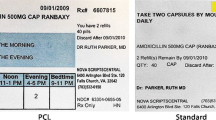Abstract
Among the goals of the Department of Health and Human Services and the Food and Drug Administration (FDA) is to improve written communication to patients about their prescription medicines. Bristol-Myers Squibb Company recognizes the need for patients to receive high-quality information regarding their therapeutic options. The company has initiated a program to prepare patient-oriented labeling for certain prescription products for which such material is appropriate, using the FDA’s proposed Medication Guide as a basis for content and format.
Similar content being viewed by others
References
Federal Register. 1968;33:8812 (21 CFR 201.305).
Federal Register. 1970;35:9O01 (21 CFR 310.501).
Federal Register. 1977;42:37636 (21 CFR 310.515).
Federal Register. 1978;43:47198 (21 CFR 310.516).
Steering Committee for the Collaborative Development of a Long-Range Action Plan for the Provision of Useful Prescription Medicine Information. Action Plan for the Provision of Useful Prescription Medicine Information. December 1996: 11.
Federal Register. 1979;44:40016.
Federal Register. 1980;45:60754.
Federal Register. 1981;46:13193.
Federal Register. 1981;46:23739.
Federal Register. 1982;47:39147.
Federal Register. 1995;60:44182.
HR 104-180.
Federal Register. 1995;60:44199.
Steering Committee for the Collaborative Development of a Long-Range Action Plan for the Provision of Useful Prescription Medicine Information. Action Plan for the Provision of Useful Prescription Medicine Information. December 1996: 3.
Federal Register. 1998;63:66378-66400.
Jones S, et al. Patient information leaflets for HIV positive patients. Pharmaceut J. Sep 8, 1990;245: 308–309.
Fleckenstein L, et al. Oral contraceptive patient information-a questionnaire study of attitudes, knowledge, and preferred information sources. JAMA. 1976; 235(13):1331–1336.
Smith D. Compliance packaging: a patient education tool. Am Pharmacy. Feb 2, 1989;NS29(2):126–137.
Kuperberg JR, et al. All in one: the user-friendly rx product. Pharmaceut Exec. April 1990:74–78.
Gibbs S, et al. The benefits of prescription information leaflets (1). Br J Clin Pharmacol. 1989;27:723–739.
George CF, et al. Prescription information leaflets: a pilot study in general practice. Brit Med J 1983; 287:1193–1196.
Glazier R, et al. Written patient information about triple-market screening: a randomized, controlled trial. Obstet Gynecol. November 1997;90(5):769–774.
National Institute of Health. Minimizing Medical Product Errors, A Systems Approach, Bethesda, MD; Jan. 8, 1998.
Sless D, Wiseman R. Writing about Medicines for People-Usability Guidelines for Consumer Medicine Information. 2nd ed. Communication Research Institute of Australia. Dickson, Australia. Ch 6, 73-96, Appendices 3, 4, 5, 121-157.
Author information
Authors and Affiliations
Rights and permissions
About this article
Cite this article
O’Connell, C.A., Skinner, R. The Patient Labeling Program at Bristol-Myers Squibb. Ther Innov Regul Sci 33, 649–654 (1999). https://doi.org/10.1177/009286159903300301
Published:
Issue Date:
DOI: https://doi.org/10.1177/009286159903300301




